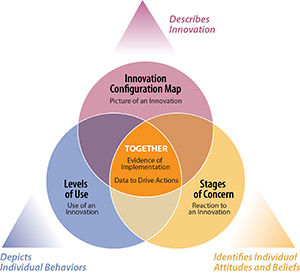Concerns-Based Adoption Model
Many education leaders have adopted a new reform or initiative with high hopes, only to see it produce few results. Successfully implementing a new program involves more than providing staff with materials, resources, and training. An often overlooked factor is the human element—the people actually doing the work. Each person will respond to a new program with unique attitudes and beliefs, and each person will use a new program differently. The three diagnostic dimensions of the Concerns-Based Adoption Model (CBAM) provide tools and techniques that enable leaders to gauge staff concerns and program use in order to give each person the necessary supports to ensure success.
The effective implementation of a new program is a highly personal developmental process. The diagnostic dimensions of CBAM are three components for assessing and guiding this process:
- Innovation Configurations: An Innovation Configuration Map provides a clear picture of what constitutes high-quality implementation. It serves as an exemplar to guide and focus staff efforts.
- Stages of Concern: The Stages of Concern process, which includes a questionnaire, interview, and open-ended statements, enables leaders to identify staff members’ attitudes and beliefs toward a new program or initiative. With this knowledge, leaders can take actions to address individuals’ specific concerns.
- Levels of Use: The Levels of Use interview tool helps determine how well staff, both individually and collectively, are using a program. Levels range from nonuse to advanced use. When combined with the Innovation Configuration and first-hand observations, this information can help staff effectively implement a new program.


